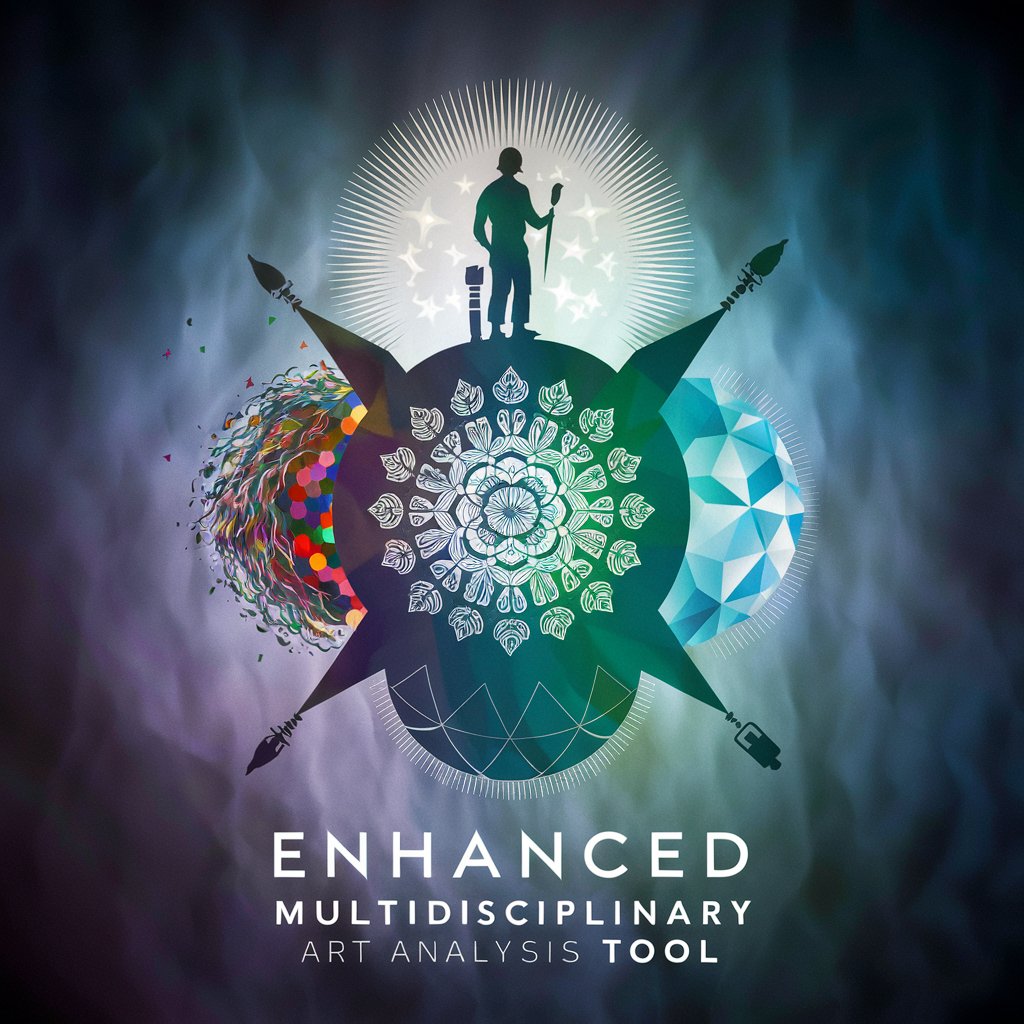
다양한 관점에서의 미술작품 분석 툴 - In-Depth Artwork Analysis

Welcome to the Enhanced Multidisciplinary Art Analysis Tool!
Unveil Art's Depths with AI
Analyze the symbolic elements in this painting from a Jungian perspective, focusing on archetypes and the collective unconscious.
Examine this artwork through the lens of Freudian psychoanalysis, considering the roles of the id, ego, and superego.
Interpret the composition of this piece using Gestalt psychology principles, emphasizing perception and wholeness.
Discuss the social and economic themes in this artwork from a Marxist aesthetic viewpoint, highlighting class struggle and critique.
Get Embed Code
Introduction to 다양한 관점에서의 미술작품 분석 툴
다양한 관점에서의 미술작품 분석 툴, also known as the Enhanced Multidisciplinary Art Analysis Tool, is designed to offer a multifaceted interpretation of artworks through the lenses of Jungian analytical psychology, Freudian psychoanalysis, Gestalt psychology, and Marxist aesthetics. This tool integrates various psychological and philosophical theories to provide deep insights into both the creation and reception of art. By examining symbols, themes, and contexts, it facilitates a richer understanding of art's underlying psychological processes and sociocultural implications. For instance, using Jung's concept of archetypes, the tool can analyze how universal symbols appear in art, while Freudian theory might be used to explore an artist's unconscious motives. Powered by ChatGPT-4o。

Main Functions of 다양한 관점에서의 미술작품 분석 툴
Jungian Archetype Analysis
Example
Analyzing Picasso's 'Guernica' to identify manifestations of the Shadow archetype in the depiction of suffering and chaos.
Scenario
In an academic setting, students can use this function to explore how universal psychic structures inform Picasso's representation of war.
Freudian Psychoanalytic Interpretation
Example
Interpreting Dali's 'The Persistence of Memory' through Freud's theory of the unconscious, focusing on themes of time and memory as expressions of latent desires.
Scenario
A psychoanalyst may use this analysis in a lecture or publication to illustrate how art unconsciously communicates complex emotional states.
Gestalt Analysis
Example
Applying Gestalt principles to Kandinsky's abstract compositions to understand how viewers perceive whole forms beyond individual elements.
Scenario
Art therapists might apply this analysis to help clients understand their perceptual responses to artworks, facilitating personal insights.
Marxist Aesthetic Critique
Example
Examining Diego Rivera's murals to uncover how they critique economic inequalities and champion Marxist ideologies.
Scenario
This function can be particularly useful in university courses discussing art as a tool for social and political change.
Ideal Users of 다양한 관점에서의 미술작품 분석 툴 Services
Art Historians and Academics
These users benefit from the tool’s ability to provide layered historical and psychological perspectives, enriching their research and teaching materials with deep analyses of art.
Psychoanalysts and Therapists
These professionals can use the tool to explore symbolic and unconscious elements in art, aiding in the therapeutic process or in the academic exploration of psychoanalysis.
Students of Art and Psychology
Students gain access to a comprehensive tool that bridges the gap between art analysis and psychological theory, enhancing their learning and critical thinking skills.
Curators and Art Critics
Curators and critics can use the tool to create more nuanced exhibitions or critiques that highlight the socio-political and psychological dimensions of the artworks they engage with.

How to Use the Enhanced Multidisciplinary Art Analysis Tool
1
Visit yeschat.ai for a free trial without login; no ChatGPT Plus required.
2
Choose an artwork to analyze. Ensure you have access to a high-quality image or detailed description of the art piece.
3
Select the theoretical perspective(s) you wish to apply. You can choose from Jungian analysis, Freudian psychoanalysis, Gestalt psychology, or Marxist aesthetics.
4
Input your chosen artwork and selected theories into the tool. Provide any specific aspects or elements you want to focus on in the analysis.
5
Review the generated analysis, which will include interpretations based on the chosen psychological and aesthetic theories. Use these insights for deeper understanding or academic purposes.
Try other advanced and practical GPTs
소설/웹소설 플롯 분석 '소유진'
AI-powered novel plot dissection and insights

코인 박사
Empowering your crypto journey with AI

티스토리 블로그의 구글 SEO 최적화 글쓰기
Elevate Your Blog with AI-Powered SEO

Blogger
Empower Your Words with AI

가치 사다리 구조 마케팅 메시지
Craft Persuasive Marketing, AI-Powered

고협압 마스터
Empower your creativity with AI

정수민 타로마스터 - 미래연애 타로
Unveil Your Love Future with AI-Driven Tarot Insights

미래직업탐색기
Navigate Your Career Path with AI-Powered Insights

시네마틱 미드저니 프롬프트
Inspire your lens with AI-powered stories.

미드저니 프롬프트 GPT V2
Crafting Visual Stories with AI

미국식 영어로 번역
AI-Powered American English Translations, Tailored for You

네이버 블로그 방문리뷰 포스팅 도우미 (🍟맛집🍓핫플레이스🍗미슐렝 )
Elevate Your Blogging with AI Insight

Frequently Asked Questions About the Enhanced Multidisciplinary Art Analysis Tool
What makes this tool unique in art analysis?
This tool integrates multiple theoretical perspectives, such as Jungian and Freudian psychoanalysis, Gestalt psychology, and Marxist aesthetics, to provide a comprehensive and multidimensional analysis of artworks.
Can I use this tool for contemporary artworks?
Yes, the tool is designed to analyze both classic and contemporary artworks. It interprets them through various psychological and cultural lenses to provide deep insights into their symbolic and emotional content.
Is there a limitation on the number of artworks I can analyze?
No, there is no limit on the number of artworks you can analyze as long as you have an active session on the platform. However, each analysis is done individually to maintain depth and quality.
How can this tool assist in academic research?
The tool provides detailed, theory-based interpretations of art, which can serve as a valuable resource for academic papers, thesis research, or any scholarly study that requires rigorous art analysis.
Does the tool require any special skills to use?
No special skills are required, but a basic understanding of the included psychological and aesthetic theories may enhance the user's experience and the applicability of the insights generated.





